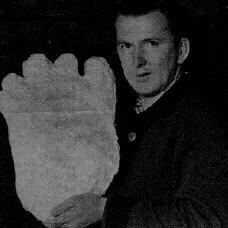


 Victoria's
Great Hairy Men
Victoria's
Great Hairy Men 
Chapter 8
Throughout the length and breadth of victoria, Aborigines know the Yowie by many names, chief of which is 'Doolagarl', or "hairy man". The Doolagarl was a large man-like beast, even given huge gorilla-like features in some areas, and therefore confused with that other 'hairy man' of Gigantopithecus features. The more man-like Doolagarl was often described as a tool-making, fire-making cannibal, whereas the more gorilla-like form was an herbivorous, insectivorous feeder. The Aborigines of Victoria, particularly the mountain tribes, as with other tribes throughout the eastern Australian mountain ranges, both feared and respected the cannibalistic form of Doolagarl or Yowie, and advised early European settlers to do the same.
These traditions have been collected and studied by a number of anthropologists, who have subsequently dismissed the 'hairy man' tales as nothing more than 'interesting' myths. However, having spent a lifetime gathering information on the Yowie mystery, I am today, more than ever convinced that the creatures cannot have been the product of imagination, but the descriptions of primitive races dating back to prehistoric times. People who have travelled and camped with the Aborigines on the NSW far south coast and down into Victoria, have been given persistent and consistent accounts of the 'hairy man' or Doolagarl who, say the Aborigines, still survives in the uninhabited, forested mountainous country inland from the coast.
The Aborigines are wary of Cockwhy and Polawombera mountains on the NSW far south coast, where, they say, numbers of the Doolagarl still live. Likewise they feared the Tathra forests wherein these creatures roamed in groups, killing and eating any Aborigines unfortunate enough to fall into their clutches. No tribesmen dared venture alone into these wilds for fear of meeting up with one or more of these man-monsters. It was a region where only large groups of food-gathering warriors dared to enter, weapons at the ready in case of contact with the dreaded Doolagarls.
I have said the Aborigines describe two distinct forms of Doolagarl; one a primitive, tool-making man-like cannibal, which sounds like Homo erectus; the other a more gorilla-like herbivorous form reminiscent of Gigantopithecus. According to the far south coastal and north eastern Victorian tribes, the gorilla-like Doolagarl was described as a hairy, big-chested, muscular beast with long, powerful legs, long, swinging powerful arms and big hands. His forehead went back from his eyebrows and his head was sunk into his shoulders, giving him a stooped appearance as he strode about the bushland.
In the old days, say the Aborigines, no tribespeople would let their campfire go out at night, for if they did, a Doolagarl might come out of the bush and carry one of them off. He would tear off arms and legs, or smash the victim's body against a tree or large boulder and eat it raw. Obviously this Doolagarl was not the vegetarian form of the 'hairy man'! Even in modern times the Aborigines of south-coastal NSW and north-eastern Victoria fear the "hairy men and women" of the coastal ranges, and have many tales of encounters with these creatures.
Take for example the story given to this author by part Aboriginal, Mr James Brittle:
"Late one afternoon in October 1978, myself and a group of several other part Aboriginal mates were returning in a truck from a bushland property outside Towamba, 16 km west of Eden, where we had been visiting friends." "As we drove along a bush track a few kilometres outside the town, the vehicle broke down, forcing us to walk a few kilometres into the town for help. Night fell and we had to use a couple of torches to see our way." "After a while, as we talked, one of my mates in the rear heard a sound, and flashing our torches back down the track, we saw the tall, dark hairy figure of a Doolagarl man-beast."
"We were terrified. We shouted at the creature, and flashed the torches at his eyes, hoping this would drive him off like our tribal elders had claimed, but it had no effect on him other than to make him shield his eyes with his big hands as he strode towards us." "We began throwing rocks and pieces of wood at him, but as he continued to approach us we took off, running frantically along the track." "After a minute or so we realised the hairy monster had vanished into the dense scrub. Catching our breath for a moment, we continued to hurry along the track."
"Eventually we reached the end of the track on the outskirts of the town, and coming out onto a sealed road, we looked back to see, to our horror the hairy man-beast again, standing in the middle of the track. He stood a good 2m tall. His face looked like a Gorilla's and he let out a sort of growling noise, before walking off into the bush. That was the last time we ever used that track, and we got the NRMA bloke to pick up the truck.
Back in the 1940's Jimmy Cook, a part Aboriginal, was employed on a farm in the Orbost district of north-eastern Victoria. One day he set out to walk into town.
An hour or two later he returned to the farm in an exhausted state, trembling and for some time unconsolable. After he had sufficiently recovered, he told his employers that, on his way along a bush road he had spotted a 'hairy man' watching him from nearby bushes. The man-sized creature began to follow him and Jimmy 'took to his heels' screaming in terror.He made for the nearby Snowy River, and upon reaching the bank, clambered over rocks, wading into the water to the opposite bank. The hairy creature, having reached the water's edge, stood watching him escape.The Orbost district was the scene of a great many 'Doolagarl' reports during the 19th century, and these have continued on through the 20th century to the present day.

















